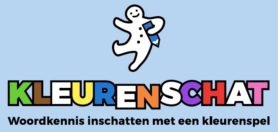Welcome to a new, innovative method for assessing language comprehension through a playful digital game. The Coloring Book method has the goal of assessing language comprehension, mainly of young children (aged 4 to 7). It can be used to test both syntax and lexicon, in children with and without language acquisition problems. Furthermore, it can be used for both monolingual and multilingual children. Previous research has shown it is an ecologically valid method, and children who participated in these studies have indicated that they found it fun to work with.
The Coloring Book method has emerged
from the need for an ecologically valid method
to test implicit linguistic knowledge
The idea is simple: Instead of pointing to the correct picture, subjects color the correct item on a coloring plate. The prompt that the subject hears contains coloring instructions. For instance, the red monkey is being scratched by the green monkey (for assessment of passive voice), and the tractor is red (for assessment of receptive vocabulary).

Pages from the Coloring Book. Left: monkey is being scratched by another monkey. Right: scene of a farm; the tractor is colored red. © Coloring Book project
The subject then colors the item in the coloring plate that they thinks corresponds to the word or to the construction in the prompt. Note that each coloring plate contains several items (for vocabulary assessment up to 10-12 different items) all placed in a natural context (a classroom, a farm, a birthday party, etc.), so that it is most ecologically valid, guessing is minimized and word and sentence recognition reflects the way they have been learned (i.e., in context).
Language research
The Coloring Book method has now been used in a number of studies (vocabulary, syntax, morphology, semantics and discourse pragmatics) and with a large variety of populations (first and second language learners, atypical language learners, adults and children). This new method has proven to be particularly successful with young children. The playful format and the familiar activity of coloring has a great appeal on children and it enables experimenters to collect objective, ecologically valid and – most importantly – novel data on language comprehension.
Education tools
The positive responses to the Coloring Book method led us to the creation of KleurenSchat, a new observation tool for receptive vocabulary in Dutch. KleurenSchat helps teachers and education professionals to observe and to measure vocabulary development in Dutch in preschoolers and first and second graders. KleurenSchat has been developed in collaboration with Boom Uitgevers Amsterdam.
You must be logged in to post a comment.



Recent Comments